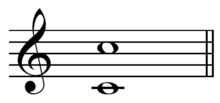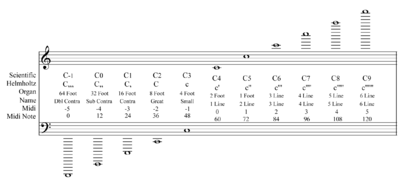Octave
| Inverse | unison |
|---|---|
| Name | |
| Other names | - |
| Abbreviation | P8 |
| Size | |
| Semitones | 12 |
| Interval class | 0 |
| Just interval | 2:1[1] |
| Cents | |
| Equal temperament | 1200[1] |
| 24 equal temperament | 1200 |
| Just intonation | 1200[1] |



In music, an octave (Latin: octavus: eighth) or perfect octave is the interval between one musical pitch and another with half or double its frequency. It is defined by ANSI[2] as the unit of frequency level when the base of the logarithm is two. The octave relationship is a natural phenomenon that has been referred to as the "basic miracle of music", the use of which is "common in most musical systems".[3]
The most important musical scales are typically written using eight notes, and the interval between the first and last notes is an octave. For example, the C major scale is typically written C D E F G A B C, the initial and final Cs being an octave apart. Two notes separated by an octave have the same letter name and are of the same pitch class.
The interval between the first and second harmonics of the harmonic series is an octave.
The octave has occasionally been referred to as a diapason.[4]
To emphasize that it is one of the perfect intervals (including unison, perfect fourth, and perfect fifth), the octave is designated P8. The octave above or below an indicated note is sometimes abbreviated 8a or 8va (Italian: all'ottava), 8va bassa (Italian: all'ottava bassa, sometimes also 8vb), or simply 8 for the octave in the direction indicated by placing this mark above or below the staff.
Theory

For example, if one note has a frequency of 440 Hz, the note one octave above is at 880 Hz, and the note one octave below is at 220 Hz. The ratio of frequencies of two notes an octave apart is therefore 2:1. Further octaves of a note occur at 2n times the frequency of that note (where n is an integer), such as 2, 4, 8, 16, etc. and the reciprocal of that series. For example, 55 Hz and 440 Hz are one and two octaves away from 110 Hz because they are 1⁄2 (or 2−1) and 4 (or 22) times the frequency, respectively.
For Calculating the Octave Range between two given frequencies one has to simply enter :
Octave Range = log ( base 2 ) Higher Frequency / Lower Frequency

After the unison, the octave is the simplest interval in music. The human ear tends to hear both notes as being essentially "the same", due to closely related harmonics. Notes separated by an octave "ring" together, adding a pleasing sound to music. For this reason, notes an octave apart are given the same note name in the Western system of music notation—the name of a note an octave above A is also A. This is called octave equivalency, the assumption that pitches one or more octaves apart are musically equivalent in many ways, leading to the convention "that scales are uniquely defined by specifying the intervals within an octave".[5] The conceptualization of pitch as having two dimensions, pitch height (absolute frequency) and pitch class (relative position within the octave), inherently include octave circularity.[5] Thus all C♯s, or all 1s (if C = 0), in any octave are part of the same pitch class.
Octave equivalency is a part of most "advanced musical cultures", but is far from universal in "primitive" and early music.[6][7] The languages in which the oldest extant written documents on tuning are written, Sumerian and Akkadian, have no known word for "octave". However, it is believed that a set of cuneiform tablets that collectively describe the tuning of a nine-stringed instrument, believed to be a Babylonian lyre, describe tunings for seven of the strings, with indications to tune the remaining two strings an octave from two of the seven tuned strings.[8] Leon Crickmore recently proposed that "The octave may not have been thought of as a unit in its own right, but rather by analogy like the first day of a new seven-day week".[9]

Monkeys experience octave equivalency, and its biological basis apparently is an octave mapping of neurons in the auditory thalamus of the mammalian brain.[10] Studies have also shown the perception of octave equivalence in rats (Blackwell & Schlosberg 1943), human infants (Demany & Armand 1984),[11] and musicians (Allen 1967) but not starlings (Cynx 1993), 4–9 year old children (Sergeant 1983), or nonmusicians (Allen 1967).[5]

While octaves commonly refer to the perfect octave (P8), the interval of an octave in music theory encompasses chromatic alterations within the pitch class, meaning that G♮ to G♯ (13 semitones higher) is an Augmented octave (A8), and G♮ to G♭ (11 semitones higher) is a diminished octave (d8). The use of such intervals is rare, as there is frequently a preferable enharmonically-equivalent notation available (minor ninth and major seventh respectively), but these categories of octaves must be acknowledged in any full understanding of the role and meaning of octaves more generally in music.
Notation

Octaves are identified with various naming systems. Among the most common are the scientific, Helmholtz, organ pipe, MIDI, and MIDI note systems.

.svg.png)
In writing, a specific octave is often indicated through the addition of a number after the note letter name. Thus middle C is "C4", because of the note's position as the fourth C key on a standard 88-key piano keyboard, while the C above is "C5", in a system known as scientific pitch notation.
The notation 8a or 8va is sometimes seen in sheet music, meaning "play this an octave higher than written" (all' ottava: "at the octave" or all' 8va). 8a or 8va stands for ottava, the Italian word for octave (or "eighth"); the octave above may be specified as ottava alta or ottava sopra). Sometimes 8va is used to tell the musician to play a passage an octave lower (when placed under rather than over the staff), though the similar notation 8vb (ottava bassa or ottava sotto) is also used. Similarly, 15ma (quindicesima) means "play two octaves higher than written" and 15mb (quindicesima bassa) means "play two octaves lower than written." The abbreviations col 8, coll' 8, and c. 8va stand for coll'ottava, meaning "play the notes in the passage together with the notes in the notated octaves". Any of these directions can be cancelled with the word loco, but often a dashed line or bracket indicates the extent of the music affected.[12]
For music-theoretical purposes (not on sheet music), octave can be abbreviated as P8 (which is an abbreviation for Perfect Eighth, the interval between 12 semitones or an octave).
First octave
In music theory, the first octave, also called the contra octave, ranges from C1, or about 32.7 Hz, to C2, about 65.4 Hz, in equal temperament using A440 tuning. This is the lowest complete octave of most pianos (excepting the Bösendorfer Imperial Grand). The lowest notes of instruments such as double bass, electric bass, extended-range bass clarinet, contrabass clarinet, bassoon, contrabassoon, tuba and sousaphone are part of the first octave.
The ability of vocalists to sing competently in the first octave is rare, even for males. A singer who can reach notes in this range is known as a basso profondo, Italian for "deep bass". A Russian bass can also sing in this range, and the fundamental pitches sung by Tibetan monks and the throat singers of Siberia and Mongolia are in this range.
Octave bands and fractional octave bands
Octave bands
An octave band is a frequency band that spans one octave. In this context an octave can be a factor of 2[13] or a factor of 100.3.[14][15]
Fractional octave bands
Fractional octave bands such as 1/3 or 1/12 of an octave are widely used in engineering acoustics.[16]
See also
References
- 1 2 3 Duffin, Ross W. (2008). How equal temperament ruined harmony : (and why you should care) (First published as a Norton paperback. ed.). New York: W. W. Norton. p. 163. ISBN 978-0-393-33420-3. Archived from the original on 5 December 2017. Retrieved 28 June 2017.
- ↑ ANSI/ASA S1.1-2013 Acoustical Terminology
- ↑ Cooper, Paul (1973). Perspectives in Music Theory: An Historical-Analytical Approach, p. 16. ISBN 0-396-06752-2.
- ↑ William Smith & Samuel Cheetham (1875). A Dictionary of Christian Antiquities. London: John Murray. Archived from the original on 2016-04-30.
- 1 2 3 Burns, Edward M. (1999). "Intervals, Scales, and Tuning", The Psychology of Music second edition, p. 252. Deutsch, Diana, ed. San Diego: Academic Press. ISBN 0-12-213564-4.
- ↑ e.g., Nettl, 1956; Sachs, C. and Kunst, J. (1962). In The wellsprings of music, ed. Kunst, J. The Hague: Marinus Nijhoff.
- ↑ e.g., Nettl, 1956; Sachs, C. and Kunst, J. (1962). Cited in Burns, Edward M. (1999), p. 217.
- ↑ Clint Goss (2012). "Flutes of Gilgamesh and Ancient Mesopotamia". Flutopedia. Archived from the original on 2012-06-28. Retrieved 2012-01-08.
- ↑ Leon Crickmore (2008). "New Light on the Babylonian Tonal System". ICONEA 2008: Proceedings of the International Conference of Near Eastern Archaeomusicology, held at the British Museum, December 4–6, 2008. 24: 11–22.
- ↑ "The mechanism of octave circularity in the auditory brain Archived 2010-04-01 at the Wayback Machine.", Neuroscience of Music.
- ↑ Demany L, Armand F. The perceptual reality of tone chroma in early infancy. J Acoust Soc Am 1984; 76:57–66.
- ↑ Ebenezer Prout & David Fallows. "All'ottava". In Deane L. Root. Grove Music Online. Oxford Music Online. Oxford University Press. (subscription required)
- ↑ Crocker 1997 Archived 2017-12-05 at the Wayback Machine.
- ↑ IEC 61260-1:2014
- ↑ IANSI S1-6-2016
- ↑ "Archived copy". Archived from the original on 2017-05-14. Retrieved 2017-11-23.
- Allen, David. 1967. "Octave Discriminability of Musical and Non-Musical Subjects". Psychonomic Science 7:421–22.
- Blackwell, H. R., & H. Schlosberg. 1943. "Octave Generalization, Pitch Discrimination, and Loudness Thresholds in the White Rat". Journal of Experimental Psychology 33:407–19.
- Cynx, Jeffrey. 1996. "Neuroethological Studies on How Birds Discriminate Song". In Neuroethology of Cognitive and Perceptual Processes, edited by C. F. Moss and S. J. Shuttleworth, 63. Boulder: Westview Press.
- Demany, Laurent, and Françoise Armand. 1984. "The Perceptual Reality of Tone Chroma in Early Infancy". Journal of the Acoustical Society of America 76:57–66.
- Sergeant, Desmond. 1983. "The Octave: Percept or Concept?" Psychology of Music 11, no. 1:3–18.